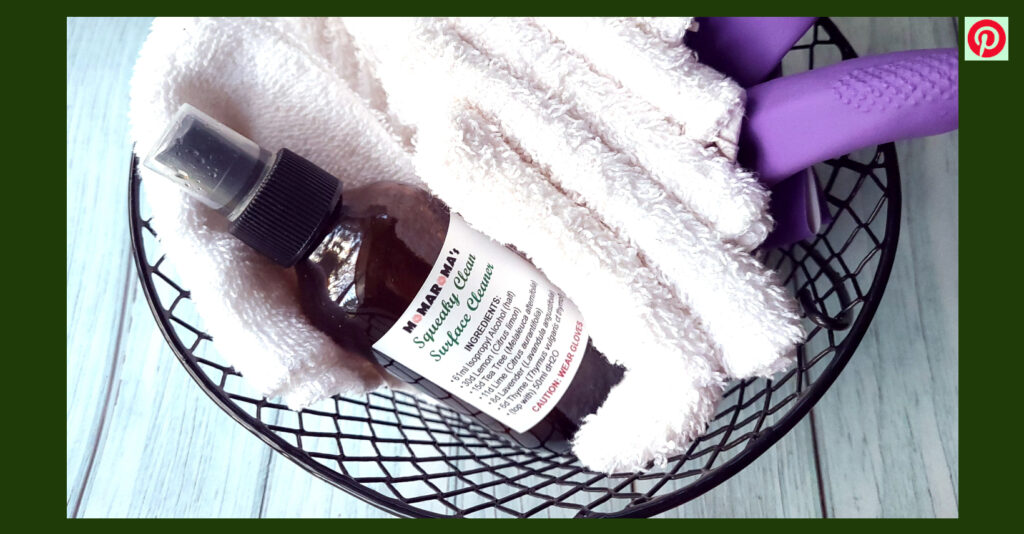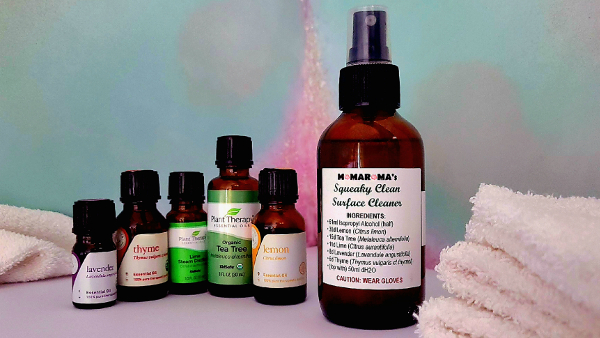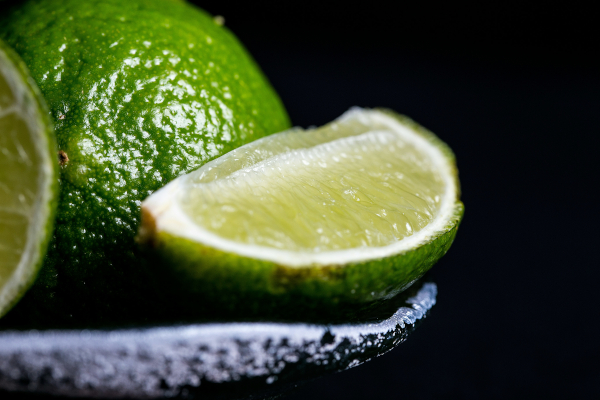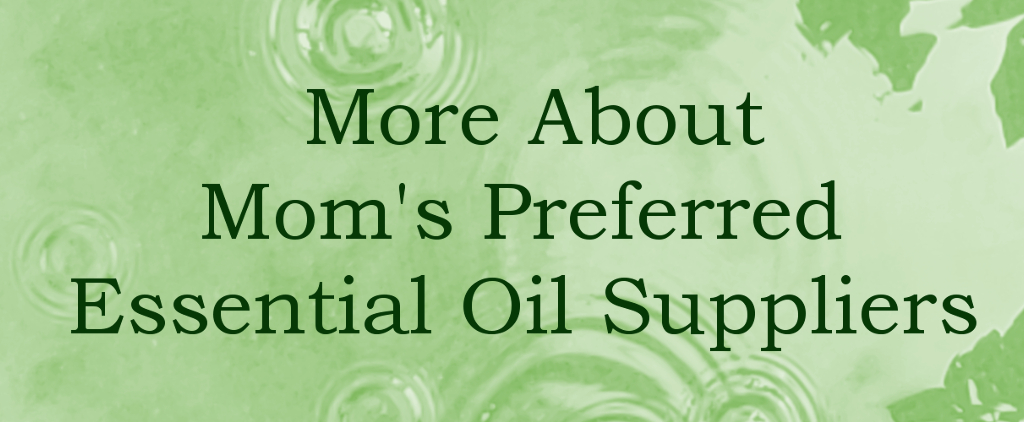Squeaky Clean Spray Surface Cleaner
Here’s an easy to make all-purpose, microbug-busting spray surface cleaner that’s sure to become a green cleaning supplies cabinet regular. It uses everyday household ingredients plus essential oils to help you keep your home squeaky clean and smelling fresh.

[This post contains affiliate links. If you make a purchase through one of these links I may earn a commission. This does not impact your price. For more information, please see our disclosure.]
In this Post:

A Green Cleaning Revolution
One positive thing came out of the empty grocery shelves in the cleaning aisle during the early months of the pandemic. This was the surge in creating DIY green cleaning products.
Vinegar, baking soda, and, when we could get it, isopropyl alcohol became cleaning staples. We all wanted to know which essential oils are natural antimicrobials. We then began to use them to help keep our homes clean and, hopefully, reduce the spread of illness.
While commercial cleaning products have returned to grocery store shelves, many of us have found we prefer our own green cleaning formulations! Using natural antimicrobial ingredients in cleaning products reduces our exposure to potential toxins, and doesn’t reduce the cleanliness of our homes.
This is one of my favorite all-purpose spot solid surface cleaning spray formulas. It’s chock full of antimicrobial essential oils(1,2,3,4) and smells great!
⭐️Squeaky Clean Surface Cleaner Recipe
- 4oz glass spray bottle
- 61ml 70% isopropyl alcohol (aka rubbing alcohol or IPA)
- 30 drops Lemon essential oil (Citrus x limon)
- 15 drops Tea Tree essential oil (Melaleuca alternifolia)
- 11 drops distilled Lime essential oil (Citrus x aurantifolia)
- 8 drops Lavender essential oil (Lavandula angustifolia)
- 6 drops Thyme essential oil (Thymus vulgaris ct thymol)
- 50ml Distilled water (or at least filtered)
🌺See my Recommended Suppliers below
Make Squeaky Clean Surface Cleaner
- Measure the isopropyl alcohol and pour into the 4oz spray bottle. The bottle should be filled about halfway.
- Add the essential oils.
- Place the spray cap on the bottle and tighten.
- Swirl to combine the essential oils and isopropyl alcohol.
- Set aside for 1 hour to allow the essential oils to solubilize into the isopropyl alcohol.
- Measure the distilled water.
- Swirl the bottle again and remove cap.
- Pour measured distilled water into the bottle. This should bring the contents to just over the shoulder of the bottle.
- Cap tightly and swirl to combine.
- And the final step: Affix a label! Since I use Squeaky Clean Surface Cleaner all the time, I include the full recipe on my label. This makes it very easy to refill.
🔸NOTE: You might notice that when you add the water, the bottle feels warm. Don’t worry! This warmth is perfectly normal. This is an exothermic chemical reaction that occurs when the water dilutes the alcohol. It’ll cool down in a few minutes.

Measuring Tips
If you want to be exact in your volume measurements at first, use a 50ml graduated cylinder. Measure the isopropyl alcohol in 2 parts (30ml, then 31ml, for a total of 61ml) pouring each measured amount into the spray bottle.
Next, affix a waterproof sticker to the bottle so the top of the isopropyl alcohol is centered on the label. Use a permanent marker to mark the level on the label. Now making your next bottle of Squeaky Clean Surface Cleaner will be a snap—just add the isopropyl alcohol to the line!😉
After the essential oils and isopropyl alcohol have rested, measure 50ml distilled water into your graduated cylinder. Pour into the spray bottle and note the final level—it should come to just over the shoulder.

💚REUSE: When I have them, I reuse the 100ml bottles of hydrosol I get from Aromatics International for green cleaning sprays. Once I’m done with the hydrosol, I remove the label and give the bottle a good scrub. I then sanitize both bottle and sprayer. Once they are both completely air dried, I set them aside for my next surface cleaning or air-cleansing blend. (I do keep several new 4oz spray bottles on hand, however. These I get from Amazon.)

Using Squeaky Clean Surface Cleaner
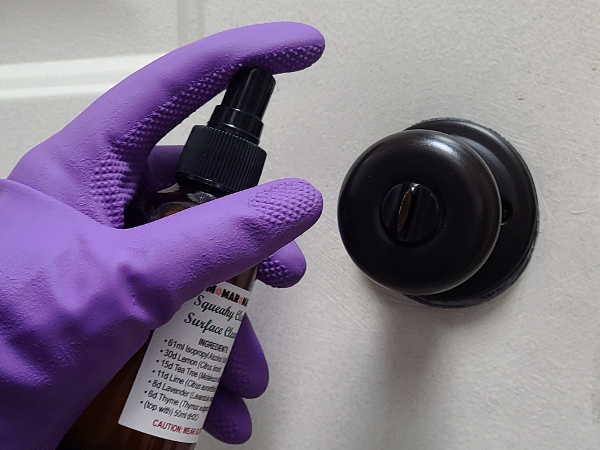
First: Always protect your hands with a pair of gloves, even when using a green cleaning product.
And Second: Always test any surface cleaner on an inconspicuous spot before using over an entire surface.
My favorite way to use Squeaky Clean Surface Cleaner is on those frequently touched small surfaces that we don’t tend to think about often—handles, doorknobs, switches, levers, and railings. Don’t forget refrigerator and microwave handles and cabinet and drawer pulls. It’s amazing what a difference just that one bit of cleaning does!
I also like its deodorizing and antimicrobial properties in the bathroom. In fact, each of my bathrooms has its own bottle of surface cleaner, because sinks and toilets get a misting on a (nearly) daily basis between regular cleanings.
Here’s how to use it. Spray the surface to be cleaned, allow to sit for a few seconds, then wipe with a cleaning cloth. Repeat if desired.
When cleaning light switches, don’t spray the surface. Instead spray the cloth and wipe.
For an extra antimicrobial punch (especially when someone in the household is sick), mist the surface again and allow to air dry. I take this extra step on doorknobs, faucet handles, and toilet flush levers especially.


🔶️IMPORTANT! Please do not use this on any pets. It is not a kitty litter box cleaner. As with any cleaning product, if you have pets in the home, please ensure they can leave the room where the product is in use, and the space is well-ventilated.

Why These Essential Oils?
One simple reason: natural antimicrobial action!
Lemon (Citrus x limon) & Lime (Citrus x aurantifolia)
Citruses, in particular Lemon and Lime essential oils, have a long history of use as cleansers. This is because they are rich in natural antimicrobial phytochemicals.(1,2) I’ve also found the citrus essential oils, especially Lemon, are excellent at lifting grime from solid surfaces.
☀️Essential Oil Spotlight: Lime Essential Oil—Distilled vs Cold Pressed
Most citrus essential oils are cold pressed from the peels of the fruit. Unfortunately, some of them, if applied to the skin and then exposed to sun or ultraviolet light (i.e., tanning beds), can cause a very serious phototoxic reaction.
Lime is one of the citrus oils that is high on the list of oils containing these photosensitizing furanocoumarins. Just 4 drops of the cold pressed essential oil in 1 ounce of carrier can result in a phototoxic reaction!
However, there’s a workaround!
Instead of using cold pressed Lime, use distilled Lime essential oil! Even if I don’t plan on getting the oil on my skin, I play it safe and use only distilled Lime. I even use distilled Lime in my green cleaning products.
Tea Tree (Melaleuca alternifolia)
Tea Tree essential oil is another oil with well-known antimicrobial properties.(1,4) Tea Tree is a regular in my green cleaning blends. It blends beautifully with citrus essential oils—my favorite is Lemon.
💚PRO TIP: If I’m in a rush or am making a small bottle of surface cleaner spray to take with me on the road, I simply combine equal parts Tea Tree and Lemon essential oils in my base of isopropyl alcohol and distilled water. Easy peasy green cleaning option!
Thyme (Thymus vulgaris ct thymol)
Another powerful natural antimicrobial, Thyme essential oil comes in two different chemotypes, each rich in different phytochemicals.(1,4) One is rich in calming linalool (great to combine with Lavender for bedtime diffusion). For green cleaning, however, I prefer the second chemotype, the one rich in microbe-busting thymol.
Lavender (Lavandula angustifolia)
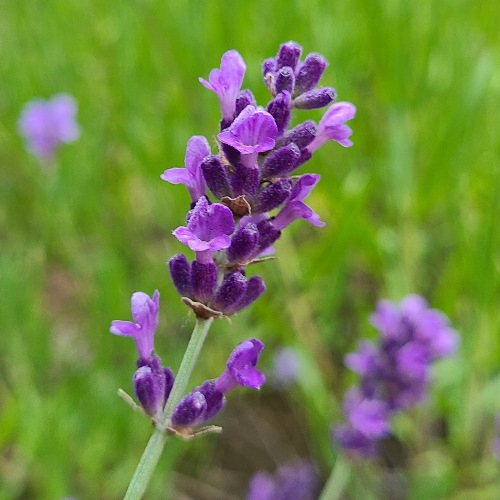
And finally, we have Lavender essential oil. Linalool is the phytochemical that contributes to Lavender’s calming nature and pleasant aroma. It also gives Lavender essential oil its effective antimicrobial properties.(3,4) As a bonus, Lavender works synergistically with other natural antimicrobial oils to enhance this property.
Have fun getting everything Squeaky Clean!
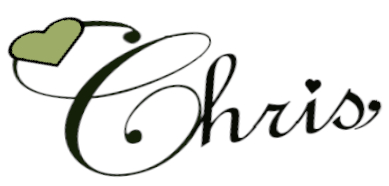
References
- Swamy, M.K., Akhtar, M.S., Sinniah, U.R. (2016). Antimicrobial properties of plant essential oils against human pathogens and their mode of action: an updated review. Evid Based Complement Alternat Med. 2016:3012462. https://doi.org/10.1155/2016/3012462
- Torimiro, N., Adegun, B.R., Abioye, O.E., Omole, R.K. (2020). Antibacterial activity of essential oil from Citrus aurantifolia (Christm.) swingle peels against multi-drug-resistant bacterial isolates. Adv in Microbio, 10: 214-223. https://doi.org/10.4236
- Ciocarlan, A., Lupascu, L., Aricu, A., Dragalin, I., Popescu, V., Geana, E-I., Ionete, R.E., Vornicu, N., Duliu, O.G., Hristozova, G., Hristozova, G., Zinicovscaia, I. (2021). Chemical composition and assessment of antimicrobial activity of lavender essential oil and some by-products. Plants, 10(9):1829. https://doi.org/10.3390/plants10091829
- Basavegowda, N., Baek, K-H. (2021). Synergistic antioxidant and antibacterial advantages of essential oils for food packaging applications. Biomolecules, 11(9):1267. https://doi.org/10.3390/biom11091267

Mom’s Shopping List
Pick up isopropyl alcohol and distilled water at your local grocer. The essential oils used in Squeaky Clean Surface Cleaner are available from my Green Cleaning shopping list on Amazon—featuring Plant Therapy and Edens Garden essential oils. Or check out the sustainably sourced essential oils from my favorite suppliers below.
For spray bottles, the Phomemo label printer I use, and other tools go to Mom’s favorite Aromatherapy Containers & Tools on Amazon.
- Lavender essential oil (Lavandula angustifolia):
- Aromatics International, organic artisan (grown and distilled in Montana)
- Plant Therapy, organic (Direct and Amazon)
- TIP: Plant Therapy’s Lavender Hydrosol (Direct and Amazon) is lovely for skin care and general aromatherapy.
- Lemon essential oil (Citrus x limon):
- Aromatics International, organic
- Edens Garden, sustainable (on Amazon)
- Plant Therapy, organic (Direct and Amazon).
- Lime essential oil (Citrus x aurantifolia):
- Aromatics International, organic, distilled💚
- Plant Therapy, sustainable, distilled (Direct and Amazon)
- Plant Therapy, sustainable, cold pressed (Direct and Amazon)
- Edens Garden, sustainable, cold pressed (on Amazon).
- Tea Tree essential oil (Melaleuca alternifolia):
- Aromatics International, organic
- Plant Therapy, organic (Direct and Amazon)
- TIP: Tea Tree Hydrosol is excellent for skin care!
- Thyme essential oil (Thymus vulgaris) – both chemotypes:
- Aromatics International, ct linalool (gentle), organic
- Plant Therapy, ct linalool (gentle), sustainable (Direct and Amazon)
- Aromatics International, ct thymol (powerful), organic
- Plant Therapy, ct thymol (powerful), organic (Direct and Amazon).
This information has not been evaluated by the Food and Drug Administration and is not intended to diagnose, treat, cure, or prevent any disease. It is for educational purposes only.
All recipes provided are for personal use and are not designed for re-sale or large-scale manufacturing.
Please consult your doctor, naturopath, herbal practitioner, or other qualified health professional for medical advice and before starting any herbal regimen, particularly if you are pregnant or nursing, have any existing medical conditions, or are taking any medications.
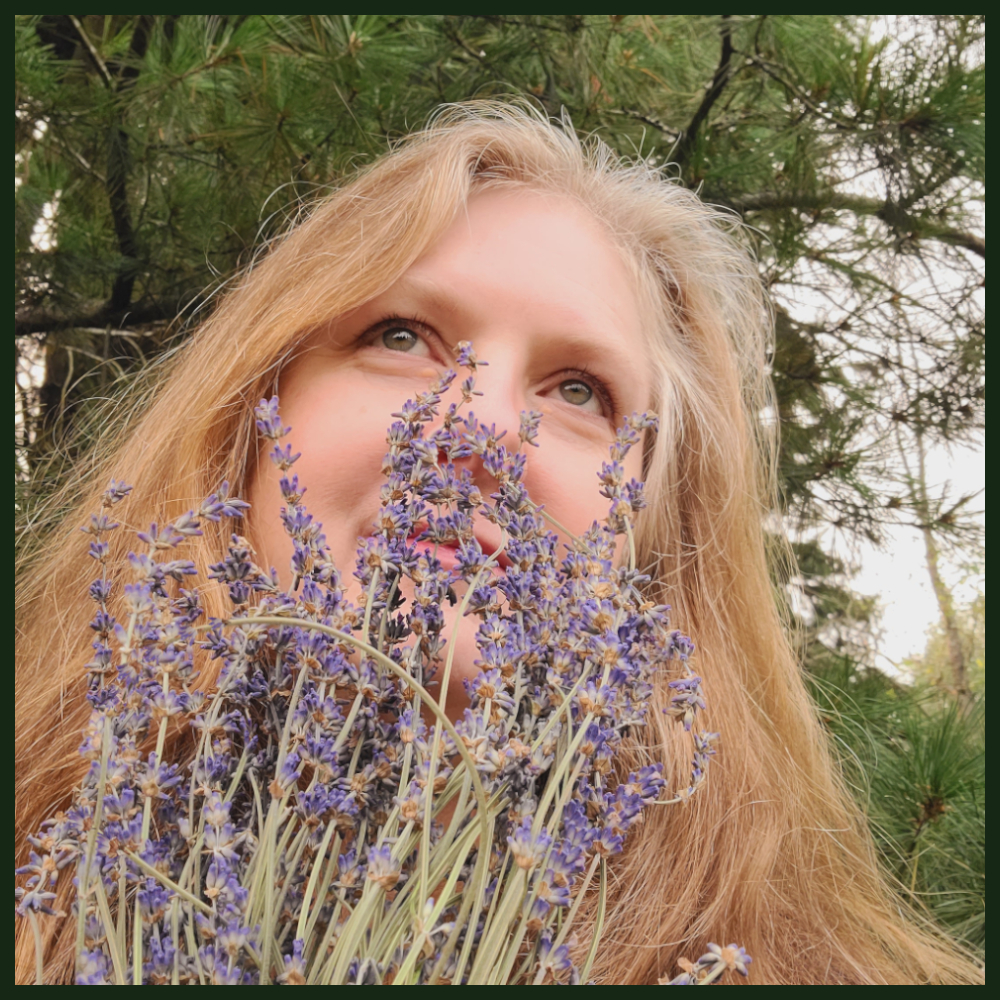
Chris P | Author, Certified Aromatherapist, Natural Skin Care Formulator
Chris (“Mom”) enjoys formulating bespoke aromatherapy, skin care, and herbal products to support her family, pets, friends, and clients. She also loves experimenting with recipes in the kitchen. An avid reader, writer, and lifetime learner, Chris enthusiastically explores research rabbit holes and then writes about her discoveries.💚 (Learn more >>)

